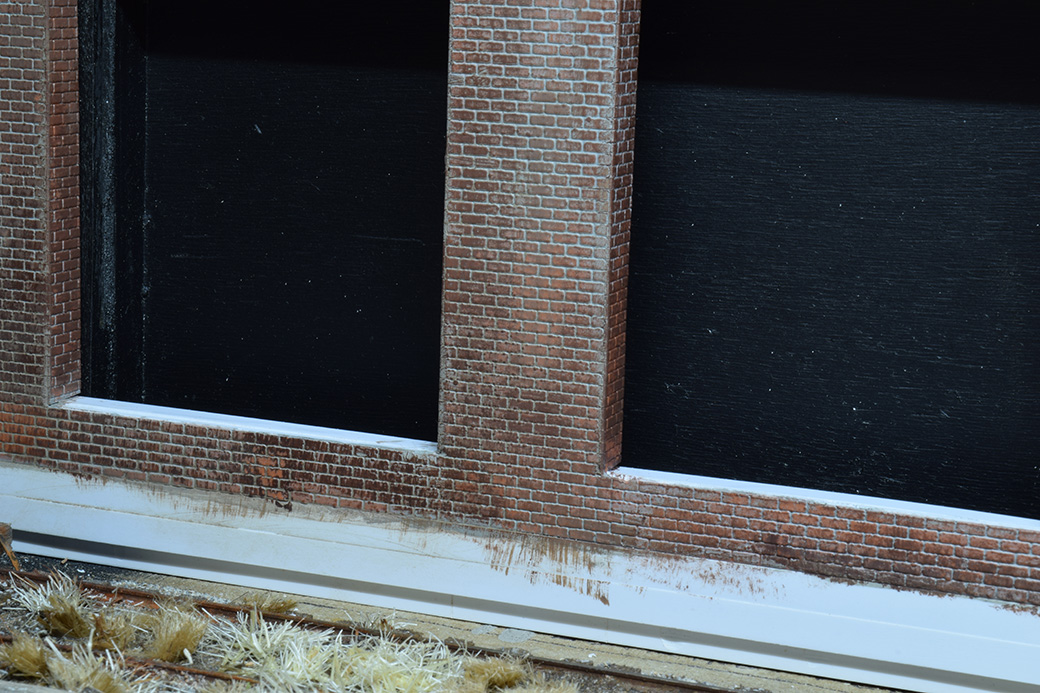I have two thoughts in mind and I don’t know if I can connect them in a coherent narrative.
The first is simple, maybe even obvious: you can always find a way to improve.
The second is about unrealistic expectations.
I began painting the brickwork on the warehouse last week. I wanted a particular outcome and wasn’t at all certain I would achieve it. The technique I used isn’t complicated but is new to me; so practicing what I preach, I did test samples to work out the colors and application sequence along with my brush techniques.
The test pieces went well and I went to the model with confidence, knowing I could fix it if things went sour. All told the initial results are satisfactory to my eyes. There is still work to do but there’s a solid foundation to build on.

However, what if I had screwed everything up?
Well, it wouldn’t have been the end of the world. I could have cleaned the first layer off and reapplied it, or simply painted over everything. The practice pieces gave me the freedom to make mistakes and learn from them without dire consequences. That’s why we practice. The knowledge that I have plenty of room to improve the work motivates me to return to it time and again.
Because the painting process was new to me, I had to focus intently on painting the wall in sections with the mortar color and then wiping it off the face of the bricks before it dried. After that step I dry brushed a light brown base color on the bricks, followed by darker highlights. To keep the brick color out of the mortar lines, I had to pay attention to the angle that I held the brush and to the amount of paint I loaded it with. None of this was hard but did require concentrated effort on my part. During the painting process, I had to let go of any preconceived expectations about the end result. My sole task was to be aware of how I handled the brush. When I evaluated the work I was pleasantly surprised at what I achieved.
Now, this is basic skills class 101. Tied to it though is the thought contained in the opening of this sentence from above: I wanted a particular outcome…
The particular outcome I wanted was an exact color match for the bricks of the full-size warehouse. Had I doggedly clung to that ideal, I would have set myself up for disappointment and frustration. Instead, and quite by accident, I focused on the process in front of me with the practice pieces. In doing, I discovered a simple joy that freed me from the unrealistic desire I started with. I also came much closer to achieving my desired outcome than I would have thought possible.
So much of what we do in this craft is driven by our desire for a particular outcome.
I need this size of layout in order to satisfy my ideals for operation.
I have to model this to be happy.
I have to make these compromises to move the project along.
We seldom if ever make these choices for their own sake. We make them because we’re married to an outcome that said choices are supposed to serve. And like as not, we’ll cling to that outcome even if doing so makes us miserable.
I question the mentality of a hobby that applauds filling out spreadsheets to schedule and guide the work, or employs business school productivity techniques and endless compromises just to produce a measurable result. I question why anyone would frame and pursue this craft in such a way that they feel guilty over a lack of visible progress. I question the value system that turned the hobby from an enjoyable pastime to a second or third full time job to produce a layout whose size and scope isn’t realistic in any sense.
You can turn model railroading into another yardstick to measure your life against (as if life doesn’t have enough empty metrics to beat ourselves up over). People who dream about the ecstasy they’ll experience when their fantasy layout is complete make their own choices and whether I agree with those choices or not is utterly irrelevant. They’re free to do their thing and I’m free to do mine. I do ask the question of why would we do this to ourselves?
Regards,
Mike
Interesting conundrum. Without some idea of a desired outcome, we may never improve. And yet, it can be too constraining at the same time.
As the saying goes, “Be careful what you wish for”!
Simon
Hi Simon,
I’m not suggesting that one totally ignore the end goal, only that you not be obsessive about achieving it. I wanted an accurate color for the model, so I paid attention to the colors I chose. However, I pretty much forgot about that goal when I painted the shell. Instead, I focused on the technique and doing a good job. I didn’t worry that the third brick in the fifth row on the right side of the fourth door was darker than the surrounding ones. I simply observed the light and dark patches and let the color evolve in a general way.
Mike